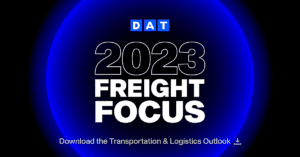After the pandemic pushed truckload rates into record-setting highs, the freight marketplace entered a down cycle in 2022. This puts motor carriers in a very different position entering the new year.
Higher expenses affect all businesses, but motor carriers operating in the spot market have felt the pain more than most, caught between falling linehaul rates and climbing costs. For typical long-haul carriers, diesel prices rose 42% in the first 11 months of 2022, and the national average was above $5 per gallon for 33 out of 48 weeks.
This has created a higher base operating cost compared to past freight cycles. Currently, those costs for a long-haul small-fleet carrier or owner-operator are between $1.70/mile and $2.05/mile, depending on the length of time in the industry, equity levels and insurance costs.
Plan and prepare for the new year with the 2023 Freight Focus.
Carriers that have been in business for a few freight cycles ran at the lower end of the range, since they typically have lower equipment repayments and insurance costs. Newer carrier – who paid more than double for a used truck in the last year as a new entrant to the industry – are at the higher end.
There should be some relief on the revenue side of the ledger by mid-year, with truckload rates expected to rebound in Q2. But the focus for 2023 will be on the expense side of the books. With thinner margins, carriers will need maximum asset utilization. That means reducing empty miles, emphasizing fuel economy and coordinating with their customers to reduce dwell times as much as possible.
With the DAT Load Board, carriers can locate loads no matter where they are, allowing trucking companies to cut their deadhead miles in half. The DAT One mobile app also allows drivers to find the best fuel prices while on the road, with discounts at the pump available with the DAT fuel card, which combines to save carriers up to $1,000 per month.
Larger carriers that are negotiating new contracts can look for opportunities to strengthen the weak spots in their network. Shippers are looking for savings after many months of transportation premiums, so offering discounts on key lanes in exchange for volume on problematic routes could be a worthy compromise. DAT iQ provides deep insights into RFP bids, allowing carriers to quote competitively while still hitting profit goals.
Potential regulations to watch
- Speed limiters: This law would require all new commercial trucks that weigh more than 26,000 pounds be equipped with devices that limit the vehicle’s maximum speed at 65 miles per hour.
- New financial responsibilities for freight brokers: These rules would require brokers and freight forwards to have higher levels of financial security in place. The Directory in DAT One allows carriers to research potential broker partners.
- Safety fitness ratings: According to the FMCSA, the agency is seeking information as to how it “might use data and resources more effectively to identify unfit motor carriers and to remove them from the nation’s roadways.”


